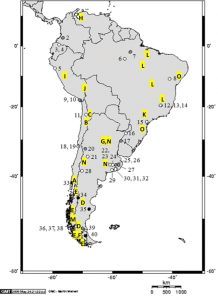 Tony Barnosky, with Charles Marshall as co_PI, has received an NSF grant that will support a highly collaborative research program to test the synergistic effects of climate change and human population growth in magnifying extinction intensity. South America offers a natural site to test these effects. Barnosky and graduate students Emily Lindsey and Natalia Villavicencio hypothesize that if human impacts were significant in causing extinctions, then the last records for taxa should be found only after humans arrived on the continent, and that the geographic pattern of extinction should follow the sequence of human colonization and population increase in different regions. If climate alone drove extinction, taxa should disappear during the most pronounced climate changes, but not necessarily coincident with first human appearance and population increase. If synergy intensifies extinction, then extinction should accelerate dramatically when increased human population pressures and rapid climate change coincide.
Tony Barnosky, with Charles Marshall as co_PI, has received an NSF grant that will support a highly collaborative research program to test the synergistic effects of climate change and human population growth in magnifying extinction intensity. South America offers a natural site to test these effects. Barnosky and graduate students Emily Lindsey and Natalia Villavicencio hypothesize that if human impacts were significant in causing extinctions, then the last records for taxa should be found only after humans arrived on the continent, and that the geographic pattern of extinction should follow the sequence of human colonization and population increase in different regions. If climate alone drove extinction, taxa should disappear during the most pronounced climate changes, but not necessarily coincident with first human appearance and population increase. If synergy intensifies extinction, then extinction should accelerate dramatically when increased human population pressures and rapid climate change coincide.
The data from South America will provide an ideal way to examine the role of synergy in triggering extinction. For that reason, the project team proposes to:
- Provide radiocarbon dates needed to determine the chronology of extinction for a broad spectrum of South American megafauna
- Contribute to the international cooperation needed to analyze the extinction chronology
- Provide a web-accessible database of the Quaternary fauna of South America, similar to NEOMAP and NEOTOMA
- Use the information to better characterize the extent to which the looming threats of rapid climate change and growing human population can intensify extinction potentials
- Develop effective outreach programs and scientific strategies to help minimize future extinctions.